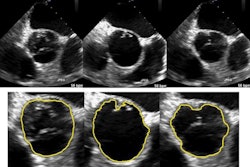Optical character recognition (OCR) software can automatically and reliably capture region-of-interest (ROI) values from images displayed on PACS viewers, potentially yielding significant time savings for radiologists, according to research published online in Academic Radiology.
Using open-source OCR software and a macro program, researchers from South Korea found that their method was 100% accurate for capturing statistical values shown on PACS viewers for ROIs and automatically inputted into a spreadsheet. The tool was also more than four times faster than conventional manual methods.
"The proposed module could be applied to the next generation of PACS or existing PACS that have not yet been upgraded," wrote lead author Dr. Young Han Lee, PhD, of Yonsei University College of Medicine in Seoul, and colleagues.
Radiologists frequently draw ROIs on images on PACS viewers, yielding statistical values such as the area, mean, standard deviation, and maximum and minimum values, according to the researchers. If needed, these figures are then typically entered manually by radiologists into radiology reports (Acad Radiol, August 12, 2014).
"Reading the ROI values from a screen and manually inputting them [risks] human errors, misrecognition, and typographical errors, which have undesirable consequences," the authors wrote. They wondered why "commercially available PACS viewers do not make it easy to save the ROIs in temporary files or to copy the values to the clipboard."
Believing that OCR technology could be of use, the researchers developed a software module based on version 0.49 of the GOCR open-source OCR software and version 1.0.48 of the open-source AutoHotkey macro program. After the module is activated via a single predefined keystroke, it converts ROI values visible on the screen into text values, according to the group.
The macro program enables mistakes such as segmentation errors, extra spaces, and misrecognition of numbers as letters to be corrected automatically, if necessary. Subsequently, the final data are copied to an Excel spreadsheet using a template.
The software was tested on a Centricity PACS RA1000 Windows-based PACS viewer (GE Healthcare) on 280 ROIs. Each ROI had five values to be recognized by the software, for a total of 1,400 recognitions.
In initial testing, the method yielded 100% accuracy. Next, the researchers measured the time it took for radiologists to input values manually and compared this process with their proposed automatic method. The manual approach took an average of 34.97 seconds, compared with just 7.87 seconds for the OCR-based technique. Even better, the OCR technique was again 100% accurate, "confirming the module's reliability."
The researchers did acknowledge one limitation of the method. Misrecognitions can occur in the presence of background signal intensity. However, in their study, misrecognitions due to background signals were easily corrected by removing the background signal after zooming out from the image, according to the group.
"By combining an OCR module with a macro program, we can extract ROI values automatically and without error," they wrote. "Manual readings and repetitive typewriting can be minimized, and a high degree of accuracy can be achieved. We expect further potential applications in radiologic reading, such as ROI subtraction on in-phase and opposed-phase MR of the adrenal gland, ROI comparison of the fat fraction map of an MR image, and a comparison of the Hounsfield unit in CT scans."



















